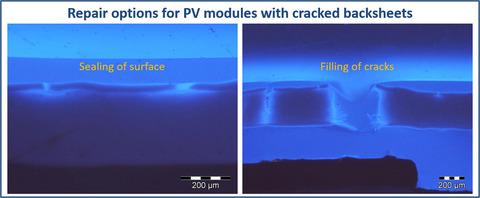当前位置:
X-MOL 学术
›
Energy Sci. Eng.
›
论文详情
Our official English website, www.x-mol.net, welcomes your feedback! (Note: you will need to create a separate account there.)
Repair options for PV modules with cracked backsheets
Energy Science & Engineering ( IF 3.8 ) Pub Date : 2021-06-20 , DOI: 10.1002/ese3.936 Yuliya Voronko 1 , Gabriele C. Eder 1 , Christian Breitwieser 2 , Wolfgang Mühleisen 3 , Lukas Neumaier 3 , Sonja Feldbacher 4 , Gernot Oreski 4 , Norbert Lenck 5
Energy Science & Engineering ( IF 3.8 ) Pub Date : 2021-06-20 , DOI: 10.1002/ese3.936 Yuliya Voronko 1 , Gabriele C. Eder 1 , Christian Breitwieser 2 , Wolfgang Mühleisen 3 , Lukas Neumaier 3 , Sonja Feldbacher 4 , Gernot Oreski 4 , Norbert Lenck 5
Affiliation

|
The paper provides a comprehensive overview of possible strategies for the repair of cracked polyamide-based backsheets. A repair process has been developed that comprises the following steps: (i) cleaning, (ii) pretreatment, and (iii) repair process (crack filling and sealing). The important topic of long-term reliability is still under investigation. Two different repair strategies have been addressed in this article: (i) repairing damage by restoring electrical insulation properties and (ii) preventing further growth of the surface near microcracks. From a technical point of view, several of the repair solutions examined met the defined requirements for compatibility and applicability. On the one hand, repair tapes/films sealed the surface and only covered the cracks. The adhesive did not penetrate into the cavities that had opened through the cracks in the backsheet material. Therefore, adhesive tapes/films are not suitable for the repair of large-scale damage and the permanent restoration of the electrical insulation properties. On the other hand, several repair coatings based on polyurethane, epoxy, silicone and synthetic rubber were identified which, after a two-step application process, showed complete crack filling and sealing of the surface. The required insulation resistance of the aged modules could be restored. Since the new and artificial reliability tests are still running, no final conclusions on the long-term behavior of the repair and its life-extending effect of PV modules can be drawn at the moment.
中文翻译:

背板破裂光伏组件的修复选项
该论文全面概述了修复破裂的聚酰胺基背板的可能策略。已经开发出一种修复过程,包括以下步骤:(i) 清洁,(ii) 预处理,和 (iii) 修复过程(裂缝填充和密封)。长期可靠性的重要课题仍在研究中。本文讨论了两种不同的修复策略:(i) 通过恢复电绝缘特性来修复损坏和 (ii) 防止微裂纹附近的表面进一步生长。从技术角度来看,所检查的几种修复解决方案均符合规定的兼容性和适用性要求。一方面,修复胶带/薄膜密封表面,仅覆盖裂缝。粘合剂没有渗透到通过背板材料裂缝打开的空腔中。因此,胶带/薄膜不适用于大面积损伤的修复和电绝缘性能的永久恢复。另一方面,确定了几种基于聚氨酯、环氧树脂、有机硅和合成橡胶的修复涂层,经过两步应用过程后,表面完全裂缝填充和密封。老化模块所需的绝缘电阻可以恢复。由于新的和人工的可靠性测试仍在进行中,目前无法得出关于修复的长期行为及其光伏组件寿命延长效果的最终结论。胶带/薄膜不适用于修复大面积损坏和永久恢复电绝缘性能。另一方面,确定了几种基于聚氨酯、环氧树脂、有机硅和合成橡胶的修复涂层,经过两步应用过程后,表面完全裂缝填充和密封。老化模块所需的绝缘电阻可以恢复。由于新的和人工的可靠性测试仍在进行中,目前无法得出关于修复的长期行为及其光伏组件寿命延长效果的最终结论。胶带/薄膜不适用于修复大面积损坏和永久恢复电绝缘性能。另一方面,确定了几种基于聚氨酯、环氧树脂、有机硅和合成橡胶的修复涂层,经过两步应用过程后,表面完全裂缝填充和密封。老化模块所需的绝缘电阻可以恢复。由于新的和人工的可靠性测试仍在进行中,目前无法得出关于修复的长期行为及其光伏组件寿命延长效果的最终结论。经过两步应用程序后,显示出完全的裂缝填充和表面密封。老化模块所需的绝缘电阻可以恢复。由于新的和人工的可靠性测试仍在进行中,目前无法得出关于修复的长期行为及其光伏组件寿命延长效果的最终结论。经过两步应用程序后,显示出完全的裂缝填充和表面密封。老化模块所需的绝缘电阻可以恢复。由于新的和人工的可靠性测试仍在进行中,目前无法得出关于修复的长期行为及其光伏组件寿命延长效果的最终结论。
更新日期:2021-06-20
中文翻译:

背板破裂光伏组件的修复选项
该论文全面概述了修复破裂的聚酰胺基背板的可能策略。已经开发出一种修复过程,包括以下步骤:(i) 清洁,(ii) 预处理,和 (iii) 修复过程(裂缝填充和密封)。长期可靠性的重要课题仍在研究中。本文讨论了两种不同的修复策略:(i) 通过恢复电绝缘特性来修复损坏和 (ii) 防止微裂纹附近的表面进一步生长。从技术角度来看,所检查的几种修复解决方案均符合规定的兼容性和适用性要求。一方面,修复胶带/薄膜密封表面,仅覆盖裂缝。粘合剂没有渗透到通过背板材料裂缝打开的空腔中。因此,胶带/薄膜不适用于大面积损伤的修复和电绝缘性能的永久恢复。另一方面,确定了几种基于聚氨酯、环氧树脂、有机硅和合成橡胶的修复涂层,经过两步应用过程后,表面完全裂缝填充和密封。老化模块所需的绝缘电阻可以恢复。由于新的和人工的可靠性测试仍在进行中,目前无法得出关于修复的长期行为及其光伏组件寿命延长效果的最终结论。胶带/薄膜不适用于修复大面积损坏和永久恢复电绝缘性能。另一方面,确定了几种基于聚氨酯、环氧树脂、有机硅和合成橡胶的修复涂层,经过两步应用过程后,表面完全裂缝填充和密封。老化模块所需的绝缘电阻可以恢复。由于新的和人工的可靠性测试仍在进行中,目前无法得出关于修复的长期行为及其光伏组件寿命延长效果的最终结论。胶带/薄膜不适用于修复大面积损坏和永久恢复电绝缘性能。另一方面,确定了几种基于聚氨酯、环氧树脂、有机硅和合成橡胶的修复涂层,经过两步应用过程后,表面完全裂缝填充和密封。老化模块所需的绝缘电阻可以恢复。由于新的和人工的可靠性测试仍在进行中,目前无法得出关于修复的长期行为及其光伏组件寿命延长效果的最终结论。经过两步应用程序后,显示出完全的裂缝填充和表面密封。老化模块所需的绝缘电阻可以恢复。由于新的和人工的可靠性测试仍在进行中,目前无法得出关于修复的长期行为及其光伏组件寿命延长效果的最终结论。经过两步应用程序后,显示出完全的裂缝填充和表面密封。老化模块所需的绝缘电阻可以恢复。由于新的和人工的可靠性测试仍在进行中,目前无法得出关于修复的长期行为及其光伏组件寿命延长效果的最终结论。


























 京公网安备 11010802027423号
京公网安备 11010802027423号